
MAY CONTAIN NUTS

Search Shorpy
SHORPY ART

Framed or unframed, desk size to sofa size, printed by us in Arizona and Alabama since 2007. Explore now.
Join and Share
Ad-Free Shorpy
Shorpy is funded by you. Patreon contributors get an ad-free experience.
Learn more.

Recent comments
- Robie House Roof(s)
- There is an interesting novel set here.
- I Was In Berlin
- Pronunciation
- Shell of a Shell
- Never been there but
- BUR-lin
- Hand-made smokes
- Birthplace of Tupperware, or at least its inventor
- Pulp
- Remarkably unchanged in 84 years
- The church is still there ...
- Talk about a smoke show
- Electric Hansom Cab
- I wondered the same thing.
- The location in 2009
- Pill Pusher
- Roll your own
- Rugged and real!
- Civil War history
- Early EV?
- A Charles Purcell - Mama Cass Connection
- Uncle SAAM
- Obfuscation
- One Chocolate Soldier rode away
- Victor Marquis de la Roche
- The Little House Across Way ...
- Vanderbilt Gates
- Vanderbilt Mansion
- You can still see that gate
Member Photos
The Shorpy
Printporium
Printporium
Search Shorpy
Search results -- 30 results per page
- Kewpee Hamburgs: 1940
- ... Michigan." Our focus here is next door, on the Kewpee Hotel restaurant, purveyor of "Kewpee Hamburgs" (a regional chain last ... Posted by Dave - 12/04/2019 - 3:14pm -
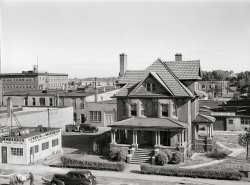
- Nomobile: 1920
- ... you can see the Fortmann Mansion, used as the McKittrick Hotel in "Vertigo." Below, the imposing edifice farther up Eddy St. in the ... Posted by Dave - 11/18/2017 - 11:59pm -
![Nomobile: 1920 UPDATE: Resident pantomath tterrace puts us at Jefferson Square Park, while Shorpy member 426hemi identifies the car as a 1922 Winton Six Model 40. Well done!
The place: San Francisco circa 1920. The tires: Goodrich Silvertown Cords. That's about all we can say about this 5x7 glass plate, whose negative sleeve is devoid of any caption information. We leave it to you to fill in the blanks. View full size.
Maybe Winton, but which model.This car has been the subject of discussion on the aaca forum pages. It would seem to be a Winton but the car in the picture submitted by 426hemi is larger. It has 34 hood louvres vs 30 on the mystery car. Note also the hood is obviously longer as you can see the second handle. I have several references which mention Winton and none agree re which model is which and in which years there were two wheelbase lengths.
[The photo below of a Winton Six, model unknown, was added by me. Comparing it to the large photo proves nothing, other than to show that both cars are Winton Sixes. - Dave]
Jefferson SquareThis is at Jefferson Square Park, previously seen here, in which you can see the Fortmann Mansion, used as the McKittrick Hotel in "Vertigo." Below, the imposing edifice farther up Eddy St. in the current shot is seen in this 1906 photo when the park was filled with post-earthquake and fire refugee tents (click to enlarge).
Chalmers?Windshield looks like this earlier Shorpy photo found here.
[Both vehicles are open touring cars with "California tops" -- aftermarket accessories that would be poor clues as to the make of the car. - Dave]
Vehicle isA Paige.
[A Paige of this vintage would have angled hood louvers, as well as the word PAIGE on the hubcaps. So keep guessing. A good clue might be the "mouse hole" lubrication port over the running board. - Dave]
No Photographer?Interesting! For an almost straight-on photo there is not a reflection of the photographer.
I'm 99% sure that this vehicle isa 1922 Winton Six Model 40 Touring Car.
[Ding ding ding! I think we have a winner! - Dave]
Just a guessAustin?
(The Gallery, Cars, Trucks, Buses, Chris Helin, Dogs, San Francisco)](https://www.shorpy.com/files/images/SHORPY-1242.thumbnail.jpg)
- The Fight: 1913
- ... appearance, the Hudson is part of the Millennium Broadway Hotel next door, and is used as a conference center and venue for special ... Posted by Dave - 03/09/2015 - 1:42pm -
![The Fight: 1913 New York, 1913. "Quality Shop and Hudson Theatre." Where the audience for Bayard Veiller's drama The Fight included a grand jury probing charges that the play was "indecent and a public nuisance." 8x10 glass negative. View full size.
The alphabet thiefis in town - see usiness en's unch.
I certainly hopethat those two usiness en enjoy their unch at Café Signage.
Business Men's LunchThree martinis and some pretzels.
Quality Replacement Letters could probably be purchased at the aptly named, and handily located, shop a mere two doors down.
[The letters are not actually missing, they're just semi-invisible thanks to the emulsions used in the days before panchromatic film. - Dave]
Red BMLI would surmise, as letters painted with that color would show up darker when using orthochromatic emulsion (no guess as to Pantone color shade though.)
Hudson Theatre is still thereIt's still in business at 141 W. 44th Street. After serving as a movie theater, studio for CBS and NBC, a legitimate theater, a porno house and finally a rock night club, the NYC Landmarks Preservation Commission declared the interior and exterior an official landmark in 1987. Now restored to its original 1903 appearance, the Hudson is part of the Millennium Broadway Hotel next door, and is used as a conference center and venue for special events.
Leo. Feist, Inc.Above the theater is one of the offices of Leo. Feist, Inc., as shown on the open windows and also by the large brass plate on the corner of the building. Leopold Feist founded and ran a music publishing firm in the early 1900s. By the 1920's, Feist was among the seven largest publishers of sheet music in the world. He had offices in major cities around he globe. His largest selling piece of sheet music was "My Blue Heaven" published in 1927. Emblazoned -- at least once on every music sheet he published -- was the slogan "You Can't Go Wrong With Any Feist Song". After his death in 1930, most of the Feist music catalog was acquired by MGM.
ComstockeryAccording to John Houchin's "Censorship of the American Theatre in the Twentieth Century", many early twentieth-century plays dramatized female sexual abuse (fueled by a moral panic over "white slavery"). What the authorities took exception to in "The Fight" was a confrontation set in a bordello, where the heroine (campaigning for public office) accuses her opponents of corrupting young women and the community for their own profit. In anticipation of the grand jury's visit, Veiller rewrote the second act and merely described the bordello scene, instead of showing it onstage, and after viewing the revised version, the grand jury dropped all charges.
(The Gallery, NYC, Stores & Markets)](https://www.shorpy.com/files/images/SHORPY-4a22195a.thumbnail.jpg)
- Immense Chewing Candy: 1904
- The Jersey shore circa 1904. "Young's Hotel and Boardwalk, Atlantic City." Where strollers confront a plenitude of ... Posted by Dave - 12/07/2013 - 9:42pm -
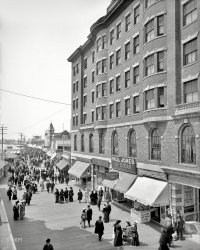
- On Broadway: 1903
- ... Avenue to the right. Also a nice view of the Albemarle Hotel and, at bottom, the obelisk of the Worth Memorial , resting place of ... Posted by Dave - 11/02/2013 - 3:03pm -
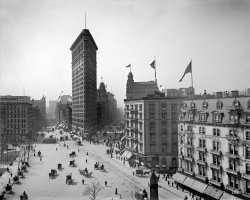
- Bird's Eye Baltimore: 1906
- ... Street from Washington Monument." At right, the massive Hotel Belvedere. 8x10 inch dry plate glass negative, Detroit Publishing ... Posted by Dave - 01/27/2014 - 10:49am -
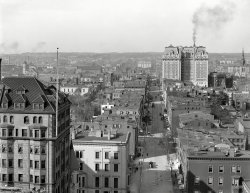
- The Worthy: 1908
- Springfield, Massachusetts, circa 1908. "Worthy Hotel." Pictured during street-cleaning hour. 8x10 inch glass negative, Detroit ... first one is a doozy. - Dave]
Do Not Disturb The Hotel Worthy is still at 1571 Main Street. It has a couple of low-end shops at ... Posted by Dave - 07/24/2012 - 9:54pm -
![The Worthy: 1908 Springfield, Massachusetts, circa 1908. "Worthy Hotel." Pictured during street-cleaning hour. 8x10 inch glass negative, Detroit Publishing Co. View full size.
Worthy barberI love the barber pole coming up from the basement steps.
[If those are steps, the first one is a doozy. - Dave]
Do Not DisturbThe Hotel Worthy is still at 1571 Main Street. It has a couple of low-end shops at street level and is used for low-income housing.
View Larger Map
Wow!I love this shot. The eagle on top of the building is the cherry on the cake. The buildings are gorgeous, the street and the cars -- well, it's just a place I would like to step into.
(The Gallery, Cars, Trucks, Buses, DPC, Horses)](https://www.shorpy.com/files/images/4a22748a.thumbnail.jpg)
- Birds of a Feather: 1954
- April 1954. "Flamingo Hotel, Las Vegas." Medium format negative for the Look magazine assignment ... Posted by Dave - 08/24/2017 - 12:39pm -
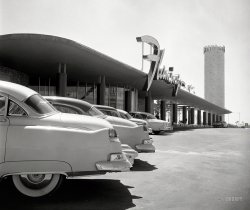
- Coming Soon: 1903
- ... ironwork, it is the prettiest thing on the block.
The Hotel Brunswick is nothing special. That we lost it is no big deal. But that ... Posted by Dave - 08/01/2012 - 5:40pm -
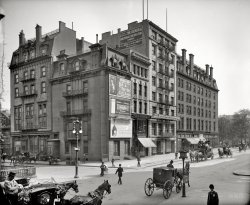
- Tri-State: 1904
- ... Grill is a restaurant. The present day area is a mixed hotel/shopping/dining complex known as Circle Centre Mall. The ever so ugly ... Court, which is in about the same location as the Claypool Hotel in the left of the DPC picture. The skinny building on the right is now ... Posted by Dave - 02/09/2019 - 2:21pm -
![Tri-State: 1904 Indianapolis, Indiana, circa 1904. "Illinois Street, north from Washington." 8x10 inch dry plate glass negative, Detroit Photographic Company. View full size.
Without a headacheBlots out all your troubles.
Weber SiteNot a single recognizable thing in the present day Street View but I wonder if Weber Drug Store has any connection to Weber Grill, which seems to have offices in the same location:
Weber GrillJust a point of correction: The Weber Grill is a restaurant. The present day area is a mixed hotel/shopping/dining complex known as Circle Centre Mall. The ever so ugly 'Arts Garden' is that spaceship-like thing that appears to have landed over the intersection.
What's There TodayThe Weber Grill is in Claypool Court, which is in about the same location as the Claypool Hotel in the left of the DPC picture. The skinny building on the right is now the site of The Conrad, which I watched go up from excavation to topping out out windows of the Lilly Arts Garden (above the intersection) or the Circle Center Mall food court.
You've outdone yourself, DaveI'm still looking for the Tri-State reference.
[It might be in Indiana. Or Illinois. Or Washington. - Dave]
(The Gallery, DPC, Indianapolis, Streetcars)](https://www.shorpy.com/files/images/SHORPY-4a17307a1.thumbnail.jpg)
- The Most Perfect Moving Pictures: 1907
- ... Bank Square at Main and Pleasant Streets, where the Eagle Hotel sits in the 1907 photo. None of the 1907 buildings appear to exist now. ... Posted by Dave - 04/23/2013 - 9:28am -
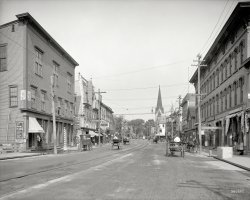
- The Palms of Pompeii: 1908
- ... Rochester, New York, circa 1908. "Pompeiian Room -- Hotel Seneca." (Catchphrase: "In the Pompeiian Room, everyone smokes!") ... Posted by Dave - 07/19/2012 - 10:26pm -
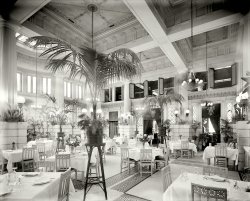
- Human Hair Goods: 1905
- ... extensive renovation into apartments and a Kimpton brand hotel.
+111 Below is the same view from July of 2016.
(The Gallery, ... Posted by Dave - 05/06/2014 - 10:26am -
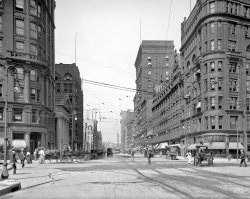
- Fashionistas: 1925
- ... This is the Connecticut Avenue entrance of the Mayflower Hotel. These ladies would be facing southwest, more or less toward the White ... Posted by Dave - 08/06/2012 - 1:56pm -

- Adrian C. Anson: 1887
- ... the design and construction of the luxurious Jefferson Hotel Richmond, which opened in 1895.
Anson helped erect the pro baseball ... Posted by Ken - 12/04/2007 - 12:20am -
![Adrian C. Anson: 1887 A baseball card for Adrian C. Anson, first baseman for the Chicago White Stockings. Issued by Allen & Ginter Company, 1887. View full size
Another look at "Cap" Anson."Cap" Anson was the was the 1st member of the 3000 hit club.
Origin of cardsI don't know how commonly known this is, but this photo illustrates the fact that baseball cards were originally introduced in cigarette packs in order to keep the cigarettes from bending over. When they later started getting popular with kids they were packaged with bubble gum.
On a totally different note, this illustration makes the guy look like he's in "Night of the Batting Dead."
"How do I get to the Susquehanna Hat Company?"
Blowing Up A Baseball Card To The Size Of A PosterBy my estimation, the "Full Image" version of this is approximately 30 times the size of what it's supposed to be, which would partially account for the somewhat pixilated effect.
[And maybe even pixelated. - Dave]
BatIt's interesting to view the evolution of baseball equipment over the decades, particularly (as this card shows) bats. Today's lumber has much more "meat" at the hittin' end, with a tapered handle that probably allows for higher swing speeds. Could this be due to better wood selection, lathing and curing techniques by the folks down there in Louisville? The lumber swung by the hitters of today's game make Cap's bat look like a fat stick.
Ginter = Richmond industrialistLewis Ginter:
http://en.wikipedia.org/wiki/Hollywood_Cemetery
http://www.lewisginterrecreationassoc.org/history.html
Major Lewis Ginter (1824 - October 1, 1897) was a prominent businessman, army officer, and philanthropist in Richmond, Virginia
Of Dutch ancestry, he was born Lewis Guenther in New York City, New York, he moved to Richmond, Virginia in 1842. Ginter had a number of careers, arguably making and losing a fortune three times. Ginter amassed a great fortune in the tobacco industry via new technology for rolling cigarettes. He used this massive fortune to act as a philanthropist and for the development of civic and business interests in Richmond. He developed the neighborhood Ginter Park and brought the Union Theological Seminary there. His niece Grace Arents continued his philanthropy, spurring the development of St. Andrew's School, the Instructional Visiting Nurse Association and the Lewis Ginter Botanical Garden at her home Bloemendaal.
He served with the Confederate States Army during the American Civil War, rising to rank of Major. His residence Ginter House sits on the Monroe Park campus of Virginia Commonwealth University.
Hired on to the John Allen & Co, he became a partner of the Allen and Ginter tobacco company that ushered in a number of innovations including cigarette cards and the use of local Virginia tobacco. In 1890 Ginter's company joined forces with James B. Duke to form the American Tobacco Co..
Ginter also commissioned the design and construction of the luxurious Jefferson Hotel Richmond, which opened in 1895.
Anson helped erect the pro baseball color barrierhttp://www.capanson.com/chapter4.html
Cap Anson was (common for the era, even in his native Iowa) a bigot. His racial attitudes were stronger than most, however, and he led efforts to exclude blacks from professional baseball.
Note that Jackie Robinson was NOT the first black to play in the major leagues -- both Fleet and Welday Walker played in 1884 before the color barrier limited baseball to the (ahem) melanin-impaired.
(Sports)](https://www.shorpy.com/files/images/0002fu.thumbnail.jpg)
- Alterations: 1966
- ... death in 1963, they owned and operated the Hindman Hotel there. I used to spend summers in McLean, and looking back, it was like ... Posted by CrankyGreg - 05/25/2020 - 12:30pm -
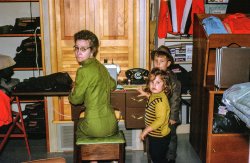
- Pool Game: 1924
- ... Washington, D.C. "Warm weather Mah-Jongg at Wardman Park Hotel pool. Left to right: Jane Eynon, Betty Carey, Helen Plummer, Ruth ... Posted by Dave - 07/18/2012 - 9:26am -
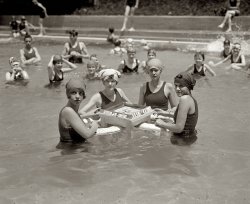
- Hobo King: 1924
- ... Feel free to expand it:
http://en.wikipedia.org/wiki/Hotel_de_Gink
Custom REO It appears to be a Reo touring body mounted ... Davis, “king of the hoboes” and founder of the Hotel de Gink, for the unemployed of New York, was received by President Wilson ... Posted by Dave - 05/01/2013 - 8:33am -
![Hobo King: 1924 August 1924. Washington, D.C. Jeff Davis, self-styled Hobo King (as well as founder of various Hotels de Gink, a chain of hostels for the homeless), standing next to his jalopy and driver. Harris & Ewing glass negative. View full size.
BuildingI believe that the out-of-focus building in the background is the U.S. National Conservatory, located immediately adjacent to the Capitol.
[Looks more like the Renwick Gallery at 17th Street and Pennsylvania Avenue NW. -tterrace]
Car?Does that say "WO" on the front? It doesn't look like a Willys Knight insignia, but it also looks like it might be painted on. The headlights are similar to a 1918-ish Willys, but the concave grille is not. Little help?
[It's a REO. -tterrace]
FascinatingI was so fascinated by this picture that I researched him and the Hotels. I created a Wikipedia article with a few of the sources. Feel free to expand it:
http://en.wikipedia.org/wiki/Hotel_de_Gink
Custom REOIt appears to be a Reo touring body mounted on a truck chassis (White?). Something easily done "back in the day."
Classy is as classy doesHe may be the Hobo King, but his car says he's "now traveling Delux." Amen to that.
Hoboes, Tramps & Bums
Washington Post, February 26, 1915.
“Hobo King” Sees President
Jeff Davis, “king of the hoboes” and founder of the Hotel de Gink, for the unemployed of New York, was received by President Wilson yesterday morning. After his visit to the White House the wanderer visited the Secretaries of State, War, Navy and Interior, in an effort to secure better legislation for the hoboes of the country.
Davis asked the President to set aside some public lands for a “Farm de Gink” for the use of the unemployed. He later discussed his project with other cabinet officers.
“Christopher Columbus was a sea hobo before he was the discoverer of America,” Davis told the President. “The unemployed are divided into three classes—hoboes who are willing to work; tramps who won't work, and bums who can't work. We are doing our best to assist the hoboes who are entitled to help from the government. Any man is apt to become a hobo at some time.” …
(The Gallery, Cars, Trucks, Buses, D.C., Harris + Ewing, On the Road)](https://www.shorpy.com/files/images/SHORPY_44426a.thumbnail.jpg)
- Pontiac Powwow: 1938
- ... October 3, 1938. "Meeting of Pontiac salesmen at Fairmont Hotel, San Francisco." Representing all the many tribes of the great Pontiac ... Posted by Dave - 03/26/2015 - 9:58am -
![Pontiac Powwow: 1938 October 3, 1938. "Meeting of Pontiac salesmen at Fairmont Hotel, San Francisco." Representing all the many tribes of the great Pontiac Nation. 8x10 acetate negative, originally from the Wyland Stanley collection. View full size.
Yum!Looks like sliced ham, green peas and scalloped potatoes. But where are the drinks?
The center table has the TOP SALESMEN for the year. Their award... they don't have to wear the silly hat!
Double whammySomething tells me in just a few years these headdresses would quickly be stuck into drawers, and not because they are insensitive to Native Americans.
Woman?I am not certain but there appears to be a single woman in the crowd ? Up against the middle of the bandstand - so how did that happen?
[She's one of the band's vocalists, along with the chap next to her. -tterrace]
Looks like room still exists!It appears that the room in which this picture was taken still exists. More info here.
James JoyceSmack in the middle: round spectacles, little moustache, jug ears. I knew he could write literature, but, man, he's also rocking that leather jacket.
Not politically correctToo many chiefs and not enough Indians.
(The Gallery, Cars, Trucks, Buses, San Francisco, W. Stanley)](https://www.shorpy.com/files/images/SHORPY-293-02A.thumbnail.jpg)
- Tumblr: 1906
- "Union Square with Naval Monument and St. Francis Hotel, San Francisco." Aftermath of the April 18, 1906, earthquake and fire. ... marks at every window of the still-standing St. Francis Hotel. The fire must have been horrible. While across the street, the ... Posted by Dave - 08/24/2014 - 1:24pm -
![Tumblr: 1906 "Union Square with Naval Monument and St. Francis Hotel, San Francisco." Aftermath of the April 18, 1906, earthquake and fire. 8x10 inch dry plate glass negative, Detroit Publishing Company. View full size.
108 yearsWow. Aside from the Dewey Monument, Union Square sure has changed quite a lot since this photo was taken!
All attempts at understatement comedic effect aside, this would make for a fabulous high-quality before and after photo. Only problem is, there are trees in the way now that might make it difficult to pull off.
Fire damage to the (partially completed) Westin St Francis is clearly evident, and it's amazing to me that they just "cleaned her up" and she's still going strong today.
Stunning and timely photo.
[There wasn't any "Westin" back in 1906, although the marketing department for that particular lodging conglomerate is probably thrilled to see people referring to it that way! - Dave]
Scorch marks at every windowof the still-standing St. Francis Hotel. The fire must have been horrible. While across the street, the buildings have toppled. The amazing column dead centre, standing. The foreground a battlefield of bricks. What an incredibly dramatic photo. And so poignant, with today's quake in the region.
+103Below is the same perspective from September of 2009.
(The Gallery, DPC, Fires, Floods etc., San Francisco)](https://www.shorpy.com/files/images/SHORPY-4a13216a.thumbnail.jpg)
- Baltimore Luggers: 1905
- ... Poking around a bit, I found a reference to the Fountain Hotel (of that era) being located at Pratt and Calvert streets. That would ... Posted by Dave - 08/19/2017 - 8:30pm -
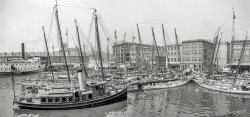
- Hobnobby Lobby: 1953
- Sept. 23, 1953. "Stevensville Hotel, Liberty, New York. General view. Herbert Phillips, client." Large-format ... school in NYC, I worked as a waiter at the New Edgewood Hotel in Loch Sheldrake, across the lake from Brown's. It could not be more ... Posted by Dave - 07/11/2014 - 6:55pm -
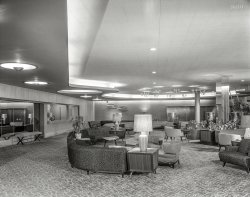
- Concrete Cadillac: 1964
- ... reason my parents had a wooden hanger that says "Cadillac Hotel, Miami FLA". To my knowledge neither one visited Miami. I ended up with ... thought it was cool. It's neat to see a picture of the hotel!
(The Gallery, Kodachromes, Florida, Miami, Travel & Vacation) ... Posted by Dave - 07/16/2015 - 1:05pm -
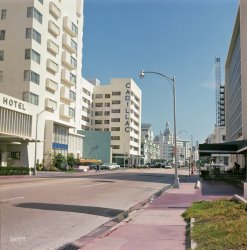
- Fancy Cakes: 1920
- Circa 1920. "Set pieces, Arlington Hotel." Including a polar pastry snowball iced with "Cook-Peary 1909." National ... was no longer the Capitol's most opulent and trendy hotel. In 1912, the original Beaux Arts building (built in 1869) was demolished ... Posted by Dave - 12/01/2014 - 10:54am -
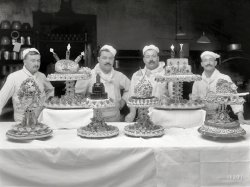
- Bee Movie: 1939
- ... a finial-topped little 'gothic' building surviving as the "Hotel Hadley"
Bank Shot This is Chatham Avenue at Raleigh Street looking ... Posted by Dave - 08/22/2014 - 10:36pm -
![Bee Movie: 1939 July 1939. "The main street, Chatham Avenue, of Siler City, North Carolina." Photo by Dorothea Lange for the Farm Security Administration. View full size.
Domes v flatsThere are five domed covers over what appear to be utility hand holes (they're too small to be man holes)in the street. Today such covers are flat. Were domed covers common in 1939?
[In the days before lane striping was common, such metal domes were used to direct traffic at intersections. In my home town of Larkspur, California, two were still in place through the 1950s, until they were eventually paved over. -tterrace]
Belk'sIn the South, we have Belk Department Stores. I think I see one in this photo down on the left. Back when I was a kid, they were known colloquially as Belk's. The company also signed and marketed them that way. My family didn't shop there; too rich for our blood.
The Happy CarIn the center of the street is a 1939 Chrysler which, because of the dip in the center of the front bumper, looks like something that was meant to be in the movie "Cars."
The model name on the leading edge of the hood is too out of focus to read, but the car is likely to be a Royal or Royal Windsor which combined totaled 45,955 out of Chrysler's 67,749 cars produced that year. There were no Chrysler convertibles in 1939, but you could order a Saratoga or New Yorker with a sun roof. Only 239 cars were ordered with the option.
Human beings!Several old photos from Siler City show lots of folks walking or standing on the sidewalks, just passing the time of day with their neighbors.
In photos of the same places today, few if any people are visible on the sidewalks. Thus, the contemporary scenes seem sterile and uninviting.
The difference is not unique to Siler City, of course.
Chatham Ave. at E. RaleighGoogle Maps doesn't have a very clear view replicating this old photograph (that I can find), but it appears that the old photograph is a view looking North-north-west up Chatham Avenue across East Raleigh Street in Siler. The Chatham Bank on the corner is now gone, but the distinctive old building remaining is up Chatham Avenue on the right, a finial-topped little 'gothic' building surviving as the "Hotel Hadley"
Bank ShotThis is Chatham Avenue at Raleigh Street looking north. The Chatham Bank building is gone, but the buildings on the west side of the street have survived.
View Larger Map
(The Gallery, Cars, Trucks, Buses, Dorothea Lange, Small Towns)](https://www.shorpy.com/files/images/SHORPY-8b34138a.thumbnail.jpg)
- Mildred Lodge: 1915
- ... not 92 degrees outdoors this day.
Mildred Lodge The hotel was owned by William Watson and his wife, Anna. The Daytona Daily News of ... the Mildred Lodge, formerly known as Mildred Villa. The hotel was named for their oldest child, Mildred May Watson.
(The Gallery, ... Posted by Dave - 08/12/2021 - 1:57pm -
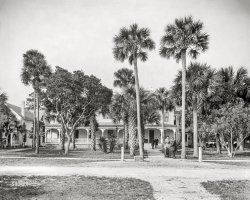
- Star Parking: 1940
- ... clock tower of the Old Post Office, soon to be the Trump Hotel D.C., rises at rear. 4x5 inch glass negative. View full size.
It ... Posted by Dave - 09/14/2016 - 1:28pm -
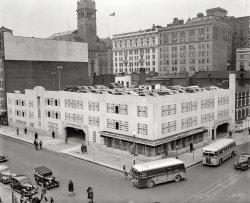
- Powder Roomer: 1940
- ... years ago, I spent a night in New Orleans at the Kentucky Hotel (or maybe the Hotel Kentucky) in a room illuminated by just such a single bare light bulb. It ... Posted by Dave - 09/02/2020 - 1:53pm -
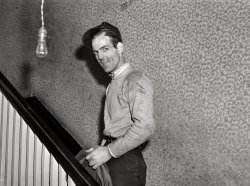
- Fatal Stroll: 1902
- ... no chance I sat on the veranda of the Mt. Washington Hotel a few summers ago and watched that cog railway go up the mountain. It was ... Posted by Dave - 10/22/2020 - 3:07pm -
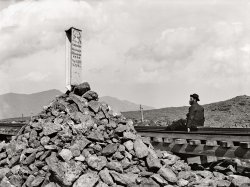
- Palm Beach: 1910
- ... Worth and the Royal Poinciana." Henry Flagler's giant hotel, Snell's tiny Menagerie, a ferry landing and other points of interest ... Posted by Dave - 01/08/2013 - 10:58pm -
























